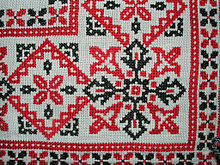Mathematics and fiber arts

Ideas from mathematics have been used as inspiration for fiber arts including quilt making, knitting, cross-stitch, crochet, embroidery and weaving. A wide range of mathematical concepts have been used as inspiration including topology, graph theory, number theory and algebra. Some techniques such as counted-thread embroidery are naturally geometrical; other kinds of textile provide a ready means for the colorful physical expression of mathematical concepts.
Quilting[edit]
The IEEE Spectrum has organized a number of competitions on quilt block design, and several books have been published on the subject. Notable quiltmakers include Diana Venters and Elaine Ellison, who have written a book on the subject Mathematical Quilts: No Sewing Required. Examples of mathematical ideas used in the book as the basis of a quilt include the golden rectangle, conic sections, Leonardo da Vinci's Claw, the Koch curve, the Clifford torus, San Gaku, Mascheroni's cardioid, Pythagorean triples, spidrons, and the six trigonometric functions.[1]
Knitting and crochet[edit]

Knitted mathematical objects include the Platonic solids, Klein bottles and Boy's surface. The Lorenz manifold and the hyperbolic plane have been crafted using crochet.[2][3] Knitted and crocheted tori have also been constructed depicting toroidal embeddings of the complete graph K7 and of the Heawood graph.[4] The crocheting of hyperbolic planes has been popularized by the Institute For Figuring; a book by Daina Taimina on the subject, Crocheting Adventures with Hyperbolic Planes, won the 2009 Bookseller/Diagram Prize for Oddest Title of the Year.[5]
Embroidery[edit]

Embroidery techniques such as counted-thread embroidery[6] including cross-stitch and some canvas work methods such as Bargello make use of the natural pixels of the weave, lending themselves to geometric designs.[7][8]
Weaving[edit]
Ada Dietz (1882 – 1981) was an American weaver best known for her 1949 monograph Algebraic Expressions in Handwoven Textiles, which defines weaving patterns based on the expansion of multivariate polynomials.[9]
J. C. P. Miller (1970) used the Rule 90 cellular automaton to design tapestries depicting both trees and abstract patterns of triangles.[10]
Spinning[edit]
Margaret Greig was a mathematician who articulated the mathematics of worsted spinning.[11]
Fashion design[edit]
The silk scarves from DMCK Designs' 2013 collection are all based on Douglas McKenna's space-filling curve patterns.[12] The designs are either generalized Peano curves, or based on a new space-filling construction technique.[13][14]
The Issey Miyake Fall-Winter 2010–2011 ready-to-wear collection designs from a collaboration between fashion designer Dai Fujiwara and mathematician William Thurston. The designs were inspired by Thurston's geometrization conjecture, the statement that every 3-manifold can be decomposed into pieces with one of eight different uniform geometries, a proof of which had been sketched in 2003 by Grigori Perelman as part of his proof of the Poincaré conjecture.[15]
See also[edit]
References[edit]
- ^ Ellison, Elaine; Venters, Diana (1999). Mathematical Quilts: No Sewing Required. Key Curriculum. ISBN 1-55953-317-X..
- ^ Henderson, David; Taimina, Daina (2001), "Crocheting the hyperbolic plane" (PDF), Mathematical Intelligencer, 23 (2): 17–28, doi:10.1007/BF03026623, S2CID 120271314}.
- ^ Osinga, Hinke M.; Krauskopf, Bernd (2004), "Crocheting the Lorenz manifold" (PDF), Mathematical Intelligencer, 26 (4): 25–37, doi:10.1007/BF02985416, S2CID 119728638.
- ^ belcastro, sarah-marie; Yackel, Carolyn (2009), "The seven-colored torus: mathematically interesting and nontrivial to construct", in Pegg, Ed Jr.; Schoen, Alan H.; Rodgers, Tom (eds.), Homage to a Pied Puzzler, AK Peters, pp. 25–32.
- ^ Bloxham, Andy (March 26, 2010), "Crocheting Adventures with Hyperbolic Planes wins oddest book title award", The Telegraph.
- ^ Gillow, John, and Bryan Sentance. World Textiles, Little, Brown, 1999.
- ^ Snook, Barbara. Florentine Embroidery. Scribner, Second edition 1967.
- ^ Williams, Elsa S. Bargello: Florentine Canvas Work. Van Nostrand Reinhold, 1967.
- ^ Dietz, Ada K. (1949), Algebraic Expressions in Handwoven Textiles (PDF), Louisville, Kentucky: The Little Loomhouse, archived from the original (PDF) on 2016-02-22, retrieved 2007-09-27
- ^ Miller, J. C. P. (1970), "Periodic forests of stunted trees", Philosophical Transactions of the Royal Society of London, Series A, Mathematical and Physical Sciences, 266 (1172): 63–111, Bibcode:1970RSPTA.266...63M, doi:10.1098/rsta.1970.0003, JSTOR 73779, S2CID 123330469
- ^ Catharine M. C. Haines (2001), International Women in Science, ABC-CLIO, p. 118, ISBN 9781576070901
- ^ "Space-Filling Curves". DMCK. Retrieved 15 May 2015.
- ^ McKenna, Douglas (24 July 2007). "The 7 Curve, Carpets, Quilts, and Other Asymmetric, Square-Filling, Threaded Tile Designs". Bridges Donostia: Mathematics, Music, Art, Architecture, Culture. The Bridges Organization. Retrieved 15 May 2015.
- ^ McKenna, Douglas (26 Nov 2023). "Designing Symmetric Peano Curve Tiling Patterns with Escher-esque Foreground/Background Ambiguity". Bridges Leeuwarden: Mathematics, Music, Art, Architecture, Culture. The Bridges Organization. Retrieved 26 Nov 2023.
- ^ Barchfield, Jenny (March 5, 2010), Fashion and Advanced Mathematics Meet at Miyake, ABC News.
Further reading[edit]
- belcastro, sarah-marie; Yackel, Carolyn, eds. (2007). Making Mathematics with Needlework: Ten Papers and Ten Projects. A K Peters. ISBN 978-1-56881-331-8.
- Grünbaum, Branko; Shephard, Geoffrey C. (May 1980). "Satins and Twills: An Introduction to the Geometry of Fabrics". Mathematics Magazine. 53 (3): 139–161. doi:10.2307/2690105. hdl:10338.dmlcz/104026. JSTOR 2690105.
- Taimina, Daina (2009). Crocheting Adventures with Hyperbolic Planes. A K Peters. ISBN 978-1-56881-452-0.
External links[edit]
- Mathematical quilts
- Mathematical knitting
- Mathematical weaving
- Mathematical craft projects
- Wooly Thoughts Creations: Maths Puzzles & Toys
- Penrose tiling quilt
- Crocheting the Hyperbolic Plane: An Interview with David Henderson and Daina Taimina
- AMS Special Session on Mathematics and Mathematics Education in Fiber Arts (2005)


